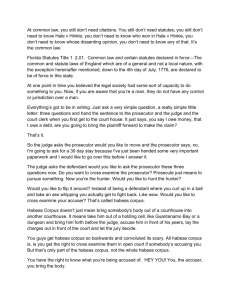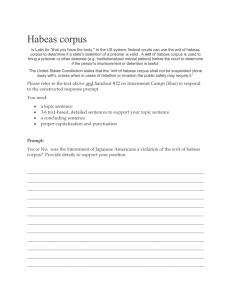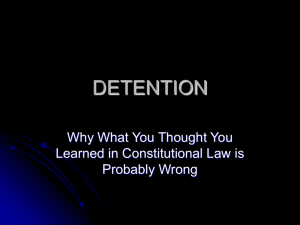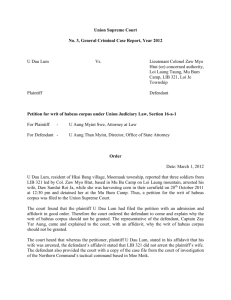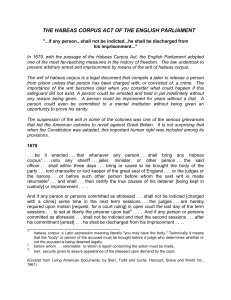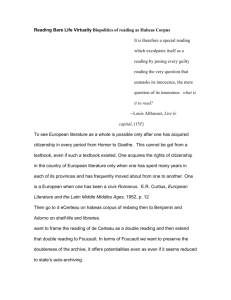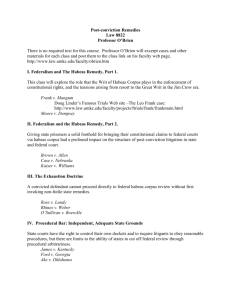Slides - Medical and Public Health Law Site
advertisement
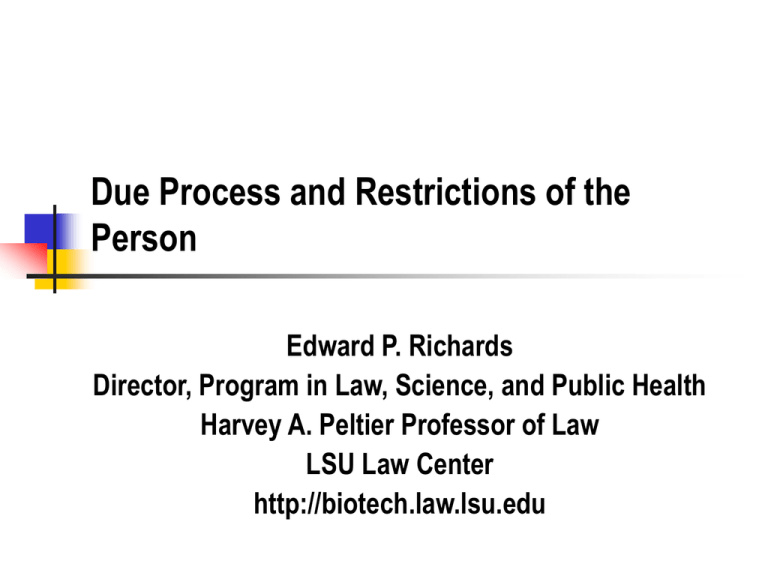
Due Process and Restrictions of the Person Edward P. Richards Director, Program in Law, Science, and Public Health Harvey A. Peltier Professor of Law LSU Law Center http://biotech.law.lsu.edu Pauline Varholy v. Rex Sweat, 15 So. 2d 267, 153 Fla. 571 (Fl 1943) What was plaintiff arrested for? What do you think the sheriff suspected was her profession? What disease is plaintiff suspected of having? How do they know? A Brief Introduction to VD Law Venereal disease - disease of love (Venus) Discarded as sexist in favor of sexually transmitted diseases (STDs) Disease is such a judgmental word, that it next changed to sexually transmitted infections (STIs) The Traditional STIs Syphilis The original and most dangerous, until HIV Gonorrhea The new favorite 2-3+ million cases a year Chlamydia Traditionally hard to diagnose so underreported Maybe as common as gonorrhea Treatment Prior to antibiotics, treatments were dangerous and not 100% effective Penicillin was the big change Widely used post-WWII Lowest rate of syphilis in the late 1940s Easier to control because it is harder to catch Gonorrhea and Chlamydia are easy to catch and everywhere, so you get reinfected VD and National Security When was Varholy decided? What was going on at the time? How was she involved in this? Why is VD a national security issue? The first national VD laws were passed during WWI The Confinement Where is she being held? Where are they going to transfer her? What were her defenses to the criminal charges? What legal process did she use to get before the court? Habeas Corpus What is the literal translation of habeas corpus? Bring the body Where did this writ originate? English, first document in 1220 AD Became important during the abuses of Charles I (1627-1640) Suspending Habeas Corpus Article 1, Section 9, Clause 2 The Privilege of the Writ of Habeas Corpus shall not be suspended, unless when in Cases of Rebellion or Invasion the public Safety may require it. LA Constitution "habeas corpus will not be suspended" When Was Habeas Corpus Suspended in a Free State? Ex parte Milligan Milligan had been an Indiana resident for some 20 years prior the outbreak of the Civil War. In late 1864 he was arrested for various alleged acts of rebellion and aiding the Confederacy, being tried, convicted, and sentenced to death by a military tribunal in May, 1865. He filed a writ of habeas corpus. The Milligan Ruling The military had no right to hold or try Milligan unless and except “in foreign invasion or civil war, the courts are actually closed, and it is impossible to administer criminal justice according to law, then, on the theatre [sic] of active military operations, where war really prevails,” martial law shall prevail. Does this include New Orleans? What Does Habeas Corpus Require? Bring the person to a judge Why do you want the judge to actually see them? When might you want to use video? Show the legal authority for the confinement Show the facts supporting the legal authority Like a prima facie case Application to Varholy What was the legal authority? Is this a civil or criminal law? What are the facts that support the confinement? Where does agency expertise come in? What will end her confinement? What about Bail? What is the purpose of bail? What assumption underlies bail? Are there criminal cases in which bail is denied? Why did the court refuse to grant bail in this case? What Process is Due? Was there a hearing before plaintiff was quarantined? What due process attended the habeas corpus hearing? How is right to counsel different for habeas corpus based on a criminal charge or an administrative detention? What process did she get in total? In re Halko, 246 Cal. App. 2d 553, 54 Cal. Rptr. 661 (Cal.App.Dist.2 1966) Roughly how long as plaintiff been confined? What disease does he have? What is the basis for his claim that he has been imprisoned without due process of law? Tuberculosis - the White Plague Killed 100,000 people a year in the US as late as 1940 Still kills more people world wide than any other communicable disease Spread through coughing, infected bodily fluids, and though milk from infected cows Controlled with isolation and treatment Tuberculosis Infection Dormant infection - converters You can be infected and the bug lies dormant for years The only evidence is a positive (converted) TB skin test Active Infection Trigger by stress, immune system problems HIV is #1 in the US Only infectious if it affects the respiratory track Treatment Converters Up to a year of preventive treatment Can have liver complications No drinking - great for the alcoholics Active disease Months of treatment with multiple powerful drugs Some still die Cannot miss doses or the bug becomes resistant MDR means you may not be able to be treated and will die Why Lock Up Persons with Active TB? Do you want one in class with you? How long can we justify locking them up? Until cured? Only as long as they infectious? What is an alternative to locking them up? DOT - directly observed treatment What if the carrier is a criminal or a bum? Halko How do you prove a case of TB? How is this different from proving a crime? How does this resemble Mathews? What standard did the court use to review the quarantine order? reasonable grounds Are persons who are quarantined entitled appointed counsel? Reynolds v. McNichols How does the case say the plaintiff described her employment? Why did the state pass this law? Had plaintiff been seen and treated by the health department before? What triggered the "hold and treat" statute? What was the "walk-in" order? Policing Vice How is that the police know if someone might be infected with an STI? What is the role of prostitution in the tourist and convention business? Do tourist/convention town really want to eliminate prostitution? Why do they make prostitution illegal? Plaintiff's Claims http://biotech.law.lsu.edu/cases/STDs/reynolds_v_ mcnichols.htm#claims Court's answer Addington v. Texas, 441 U. S. 418 (1979) What is the history of plaintiff's behavioral problems? Were any of these crimes? Has he been treated for these problems in the past? What problems did he pose in treatment? What is the state seeking to do in this case? What must the Fact-finder Determine? (1) whether the proposed patient is mentally ill, and if so (2) whether he requires hospitalization in a mental hospital for his own welfare and protection or the protection of others, and if so (3) whether he is mentally incompetent. What Type of Detention? How is a mental health commitment different from a criminal incarnation? What is the purpose? What is the duration? What about the facility? What about sex offenders – where do we keep them? Analyzing the Factors What if he is not mentally ill but is a danger to others? What if he is not mentally ill but is a danger to himself? What if he is mentally ill, a danger to self/others, but competent? Due Process What started this proceeding? What can you do in LA? What type of fact-finder? Was he represented by counsel? Standard of Proof What standard did plaintiff say was constitutionally required? What standard do we usually see in civil proceedings? What standard did the Texas trial court use? What standard did the Texas Supreme Court said would have been OK? United States Supreme Court While the court does not mention Mathews, how does the discussion of standards of proof track the Mathews analysis? What other cases have used the clear and convincing standard? Why? How important is the distinction? What is the Source of Legal Authority? Which mental health commitments are done under the police power? Which are done under parens patria? Which power justifies more restrictions? How does this play out in mental health? Clear and Convincing What were the courts reasons for using this standard? What about the argument that it really does not matter? What is the stigma issue? Least Restrictive Alternative Used by many states in mental health Rejects the Mathews analysis and requires the state to provide the least restrictive alternative for confinement, without regard to state resources. Examples Supervised community placement No medication without the patient’s consent What has been the response of the states? City of Newark v. J.S., 652 A.2d 265 (N.J.Super.Law Div. 1993) What diseases does plaintiff have? Which is at issue in this case? What does the city want to do? What federal law does the judge think applies? Due Process What Due Process does the NJ Law Provide? What state does the judge look to? What does that state provide? How old is that law? Why do you think it was changed to give lots of due process? What was the impact on the state’s TB rate? The Judge’s Approach What NJ law does the judge look to? What are the parallels between the conditions? What are the differences that should matter for due process purposes? Sheldon v. Tucker, 364 US 479 (1960) The judge implies that this case support LRA for disease control cases The case is about making teachers give the state a list of all the organizations they have belonged to for the past 5 years What constitutional provisions does this trigger? How is this different from disease control? Covington v. Harris, 419 F.2d 617 (1969) Plaintiff is asking to be transferred from a maximum security psychiatric ward to a general ward The court finds that the original order did not address the need for this additional security The case was remanded to allow the hospital to demonstrate why plaintiff posed the additional risk Does this support the judge's argument? Is the Judge Being Honest? Do these cases really apply to disease control cases? Why or why not? Green v. Edwards, 263 SE 2nd 661 (1980) This case deals with the W.V. statute, which was modeled on the W.V. civil commitment statute The court found that counsel has been appointed too late in the proceeding, based on decisions construing the civil commitment law In this case, the legislature did seem to intend to treat the diseases in a similar manner No US Constitutional issues The ADA The ADA does not apply, and subsequent cases make it clear that threat to others (Arline) is also part of the ADA exclusions This is beyond the scope of this course The Judge’s Ruling What Standards did the Judge Apply? What scholarship influenced his decision? Did he disagree with the agency? Why should we care about standards in this case? How might it play out in LA under these standards? What might it cause agencies to do? SARS, Smallpox, and the End of Life as We Know It SARS quarantine Possible smallpox quarantine and isolation issues How would the standard in JS work? Would an administrative determination with habeas corpus review to the courts be constitutional? What are the risks of a LRA standard if you cannot meet it?
